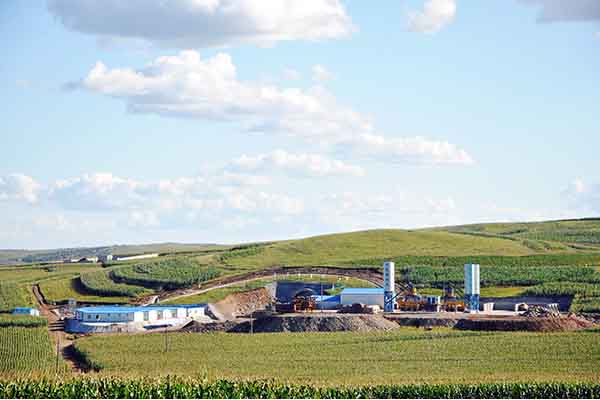

The construction project requires a large amount of concrete. If manual mixing is used, it is not only laborious, laborious, low in productivity, but also wastes cement. It is difficult to ensure quality. Therefore, currently, concrete mixers are commonly used in construction. The use of concrete mixing plant to prepare concrete must be based on the concrete engineering situation and the reasonable selection and proper use of mixers can reduce construction costs and ensure construction quality.
to sum up:
1. Types and characteristics of concrete mixing plant
Concrete mixers can be divided into two types: periodic and continuous according to the continuity of the production process. The feeding, stirring and discharging of the periodic mixer are performed in a cycle, which is easy to ensure the quality of the concrete. The mixers used at the construction site belong to this category; the feeding, mixing and discharging of the continuous mixer are performed continuously, and the quality of the concrete is difficult to guarantee. Hydraulic construction.
According to the type of power, it can be divided into electric and internal combustion. It can be selected according to the power situation of the construction site. According to the form of the device, it can be divided into two types: fixed and mobile, which can be selected according to the amount of concrete and construction requirements.
According to the mixing method, it can be divided into two types: forced and self-dropping. The self-falling mixer uses the blades in the rotating mixing drum to bring the mixed material to a high place, and then falls by its own weight to stir. The forced concrete mixer is rotated by the rotating blades. The mixture is forcedly squeezed, turned, and stirred.

2. Use of concrete mixer
The use of concrete mixers must strictly abide by the "Safety Technical Regulations for the Use of Construction Machinery". Before use, the power equipment, working mechanisms and supporting lifting and transportation pouring equipment must be carefully checked.
Starting and feeding of concrete mixer: The mixer must be started with no load and charged during operation, otherwise the machine will be damaged due to excessive starting torque. When mixing the concrete with a mixer, the input amount must be calculated according to the specified ratio of ingredients and water-cement ratio. The humidity of coarse and fine aggregate should be measured in advance, and the theoretical mixture ratio should be converted into the construction mixture ratio. Then, the construction mixture ratio and the output of the mixer The capacity calculates the mass of each constituent material to be added each time. The calculated value of the feed should be tested and implemented strictly once it is determined. The particle size of the largest aggregate should meet the requirements. The requirements for the maximum aggregate particle size of the compulsory mixer are more stringent. Otherwise, jamming will occur. If the added material changes or the humidity changes due to rain, snow, etc., it should be re-measured, and the amount of feed added should be recalculated and determined. Important concrete structures, expense ratios and water-cement ratios should be checked every 4 hours.
When adding materials to the mixing drum, the traditional methods are: (1) first load sand, then add stones and cement in sequence, and add water in time; (2) first add part of the water and sand, and then add the stones, cement, and the remaining water Loading; (3) When using a hopper to feed, the material should be fed into the mixing drum within 15 seconds in the above order. The above method can avoid cement sticking to the bucket wall, reduce wear and improve productivity, but the strength of the concrete is reduced, and the cement consumption is large; it is best to use the stone-wrapping method of mixing the cement slurry first. It must also be pointed out that the feeding capacity of the concrete mixer should conform to the mechanical capacity. Too small will reduce the productivity; too large will not only increase the load of the power machine, but also cause the concrete slurry to spill and splash, and the mixing efficiency will decrease. In addition, when the current concrete has not been completely unloaded, new mixing materials must not be charged.
3. Mixing time of concrete mixing plant
The mixing time of the concrete mixer (the time from the end of loading to the beginning of unloading) can be determined according to the slump of the mixture and the capacity during mixing. In order to ensure uniform mixing, the mixing time of medium and small self-dropping mixers is about 3 minutes, and the mixing time of forced concrete mixers is short, such as 30 seconds. In short, it can be determined by testing according to actual construction conditions. . For smaller slump (1 to 2 for mechanical vibrator tamping and 2 to 4 for tamping, and concrete with fine sand, the mixing time can be extended according to the actual situation.